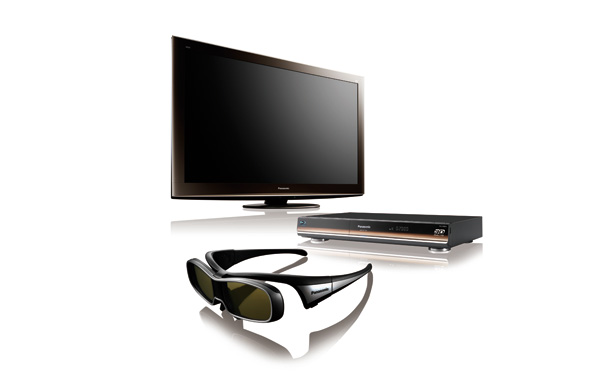Electronics giant Panasonic yesterday unveiled its 3-D TV lineup for 2010, a launch it describes as its “biggest ever”. But while competitors such as Sony and Samsung are rolling out their 3-D offerings with LCD displays, Panasonic is sticking resolutely to plasma – or what it’s now calling NeoPDP (Neo Plasma Display Panel).
Starting from $3,299 for a 42-inch model, Panasonic argues that its new-and-improved plasma systems refresh faster and all but eliminate the annoying phosphorous afterglow that’s usually associated with plasmas. Picture quality is claimed to have gone through a substantial improvement as well – Panasonic actually absorbed the Kuro development team after Pioneer ducked out of the flatscreen business. That said, black levels have been improved, whites are ‘whiter’ and the screens consume less power than before. So sure of these claims were they that they showed us last year’s screens side-by-side with this year’s new models; and sure enough, the picture was definitely better – but only because we were told to look for those differences.
The real test comes with the screen’s performance with 3-D, however – that’s where the refresh rate and reduced afterglow can have a startling effect on whether the image appears blurred or objects in the periphery of your screen start flickering in time with the shutters of the 3-D glasses. Again, the TV passed with flying colours: Panasonic’s 3-D glasses, while slightly clunky, delivers a crisp and virtually flicker-free 3-D experience. Better still, there was no loss of quality or contrast through the 3-D glasses when tilting one’s head to the side 90-degrees while viewing the screen.
The new NeoPDP screens from Panasonic will also come equipped with expanded Vieracast IPTV functionality. That is, it can connect online and display Youtube videos and content from broadcast partners such as Yahoo!7. The connection is made via ethernet, but it can also do so wirelessly via a dongle purchased separately.
In another bid to turn living room televisions into the communications hub of the household, the new NeoPDP screens also support Twitter and Skype Video – a separate specially-designed skype camera will have to be purchased in order to take advantage of Skype Video, and it isn’t compatible with previous Viera Plasma models from Panasonic (no USB ports in the older TVs, you see). Once installed, you’ll be able to use an existing Skype account to conduct video calls over your large-screen television, as opposed to conducting calls with the entire family hunched over a tiny computer screen.
Of course, enjoying 3-D entertainment on the new Viera NeoPDP screens will only be possible with at least one additional purchase: The 3-D glasses. Panasonic reps have stated that each Viera NeoPDP screen will come bundled with one pair of 3-D glasses. It might be possible to secure a second pair by registering one’s details at an upcoming 3-D TV roadshow across all of the major capitals; but otherwise, additional pairs of 3-D glasses will set you back a meaty $199.
Why so expensive? And would anyone actually pay that much? That’s ultimately going to be up to consumers, but if you want an understanding of Panasonic’s thinking, their research suggests that 50 per cent of consumers would pay 25 per cent more for a television if it included 3-D.
That said, the 3-D TV and the glasses will be useless without content. 3-D broadcasts are at least a year away for Australia, and that’s why Panasonic hopes you might consider its new 3-D-enabled Blu-ray player. — Kevin Cheung
Popular Science has been a leading source of science, technology and gadget news since 1872. With up-to-the minute latest space news, insightful commentary on the new innovations and concept cars ...if it's new or future technology you'll find it at popsci.com.au.






